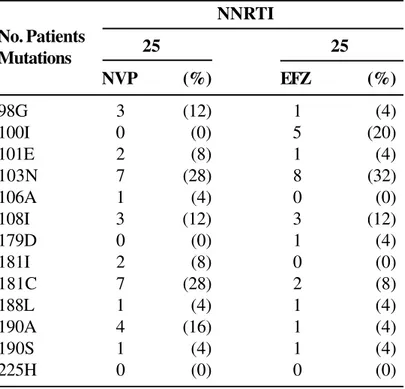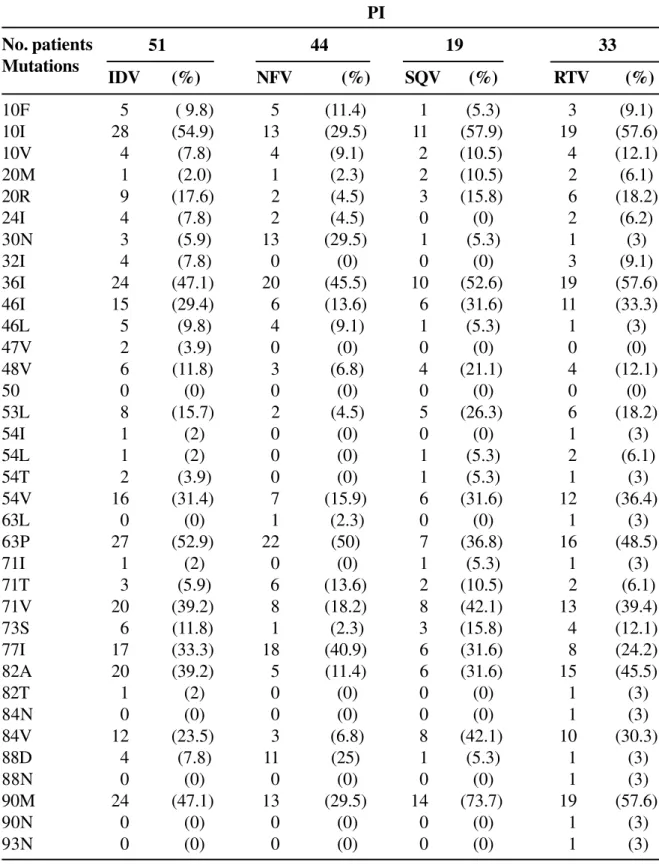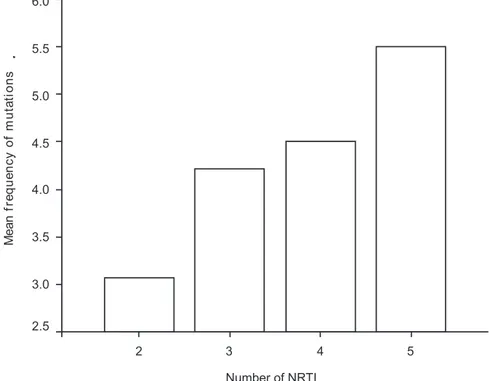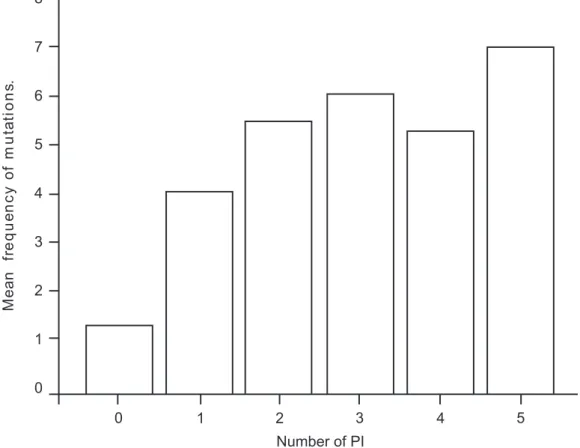Received on 17 February 2004; revised 23 July 2004.
Address for correspondence: Dr. Fabianna Bahia. Hospital Universitário Prof. Edgard Santos. Rua João das Botas, s/n, Canela. Zip code: 40110-160 Salvador – Bahia – Brazil. Phone: (55 71) 235-4901. Fax: (55 71) 247-2756.
E-mail: faubahia@hotmail.com
The Brazilian Journal of Infectious Diseases 2004;8(4):281-289 © 2004 by The Brazilian Journal of Infectious Diseases and Contexto Publishing. All rights reserved.
Evaluation of the Genotypic Pattern of HIV-1 Resistance
in AIDS Patients Failing Antiretroviral Therapy
Fabianna Bahia1, Célia Pedroso1, Federal University of Bahia1, Salvador, BA; Santa Casa Eduardo Martins Netto1, Ricardo Figueiredo1, de Vitória2, Vitória, ES, Brazil
Lauro Pinto Neto2 and Carlos Brites
We analyzed the first 96 patients tested for HIV resistance to antiretroviral therapy in three Brazilian states. The HIV-1 reverse transcriptase (RT) and protease (PR) were sequenced by using the ABI ViroSeq system. The drugs previously used for each patient were recorded and correlated with the mutations found in the samples. Viral load (VL) and CD4 count were also recorded. Only one patient had the wild type sequence. The most prevalent mutations were: 184V (59%), 41L (47.9%), 63P (53%), 215Y (50%), 36I (46%), 10I (35%), 67N (42%), 77I (37%), 90M (36%) and 210W (33%). A positive correlation between the number of previously used ARVs and the number of mutations was observed (p<0.05). Associations between mutations and ARV drugs were identified at positions 69, 118, 184 and 215 with previous exposure to NRTI, mutations at positions 98, 100, 103, 181 and 190 with previous NNRTI use and at positions 10, 20, 30, 46, 53, 54, 71, 73, 82, 84, 88 and 90 with previous PI therapy (p<0.05). Previous exposure to ARV drugs was associated with previous genotypic resistance to specific drugs, leading to treatment failure in HIV patients. Genotypic resistance was clearly associated with virological and immunological failure.
Key Words: HIV-1, mutations, resistance, antiretrovirals.
In patients under highly active antiretroviral therapy (HAART) for HIV-1, viral resistance is the main cause of antiretroviral therapy failure and of failure of subsequent treatment options [1-4]. Experience based on clinical trials has led to the suggestion that genotypic or phenotypic tests can help physicians guide therapeutic management of HIV-1 infected patients failing HAART [5-9].
The high replication rate of HIV-1, in addition to its high degree of genetic variation, allows the onset of viral mutations that confer resistance to all currently available antiretroviral drugs [10,11]. There are more than 200 different mutations
interacting in many ways, leading to viral resistance, making the interpretation of genotypic and phenotypic tests very complex [12].
The Brazilian Ministry of Health started a program to evaluate the use of HIV genotyping in the management of antiretroviral therapy (RENAGENO). Patients failing first or second protease inhibitor (PI) containing regimens, or first non-nucleoside based therapy (NNRTI), or double therapy, are eligible for testing. We analyzed the genotypic profile of 96 patients tested for resistance in three Brazilian states in order to determine the frequency of mutations and its association with previous ARV drugs used by patients.
Materials and Methods
Laboratory evaluation
The HIV-1 reverse transcriptase (RT) and protease (PR) genes were sequenced by using AppliedBiosystems ViroSeq 1, according to manufacturer’s instructions. Demographic data, previous use of antiretrovirals, viral load and CD
4 counts were recorded. Four results of viral load and CD
4 count were obtained: before antiretroviral therapy, after antiretroviral therapy, after treatment failure and the lowest result of viral load and CD4 count.
Statistical analysis
Prevalence ratio was used to compare differences in frequencies. A comparison of mean CD4 count and viral load was made with the paired sample Student’s t test. We studied the association between resistance to ARV drug and a mutation at a given position, using a chi-square test, or a Fisher test if necessary. Logistic regression analysis was performed to study the linear relationship between the number of ARVs and mutation prevalence. We used a significance level of 0.05 and a Confidence Interval (CI) of 95%.
Results
A total of 96 patients were evaluated (69% males). The mean age was 40.7 ± 12.5 years. Seventy-eight (81%) were from the state of Bahia, 15 (16%) from Espírito Santo and 3 (3%) from Sergipe. The mean CD
4 counts and viral load were calculated (Table 1). All means, when compared at each time point, using paired Student’s t tests, were significantly different (p<0.05), except for the comparison between CD4 count after treatment failure/before treatment and CD
4 count after treatment/after treatment failure (p=0.99 and p=0.24 respectively). All viral load measurements was significantly different (p<0.05), except for VL before treatment and after treatment failure (p=0.65) (Table 1). The ARV drugs that were previously used were: AZT (95.8%), 3TC (87.5%), DDI (72.9%), D4T (55.2%), IDV (53.1%), NFV (45.8%), RTV (34.4%),
NVP and EFV (26% each), SQV (19.8%), DDC (5.2%), APV and LPV (4.2% each) and ABC (1%). Only one patient presented with a wild type sequence. The most prevalent mutations were 184V (59%), 63P (53%), 215Y (50%), 41L (48%), 36I (46%), 67N (42%), 77I (37%), 90M (37%), 10I (35%) and 210W (33%). The frequencies of all mutations associated with ARV drugs are listed in Tables 2, 3 and 4 divided by ARV categories (NRTI, NNRTI and PI).
A positive correlation between the number of ARVs previously used and the number of mutations was observed. The mean number of NRTIs used was 3.2 ± 0.9 drugs/patients. Forty-four patients used NNRTI (mean number of drugs used: 1.1 ± 0.3/patient). Among 88 patients who used PI, the mean number of drugs used was 1.8 ± 0.9. Figures 1 and 2 show a positive correlation with the number of drugs (NTRI and PI) used and the number of mutations identified by genotyping. Specific analysis of NNRTI was not done due to the characteristics of this class of drug (cross-resistance), which did not allow the use of a second drug after failure of the first one used. Chi-square analysis revealed associations between some mutations and previous exposure to ARV drugs. Mutations 69D and 118I were associated with previous exposure to Stavudine (D4T), mutation 184V was associated with previous exposure to Lamivudine (3TC) and Didanosine (DDI), and mutation 215F/Y, with prior use of D4T and DDI (all p values < 0.05, Table 5).
We found an association between mutations 181I/ C and 190A/S and exposure to Nevirapine (NVP). Although we detected a significant association between mutation 98G and NVP resistance (p=0.016) and mutation 100I and EFZ resistance (p=0.001), it was not possible to define the prevalence ratio, since at least one cell was equal to zero (Table 6).
Mutations at positions 10, 20, 30, 46, 53, 54, 71, 73, 82, 84, 88 and 90 were associated with prior therapy with specific protease inhibitors (Table 7).
Discussion
Table1. Evolution of mean CD4 count and viral load over time in patients under HAART
Table 2. Frequency of mutations according to previous use of nucleoside reverse transcriptase inhibitors (NRTI)
Evolution CD4 (cells/mm3) ± SD VL (log 10) ± SD
Before HAART 276.7 ±204.2 4.8 ±0.9
1st value post-HAART 331.2 ± 239.2 4.1 ± 0.9
Lowest value during HAART 122. 4 ± 107.8 3.4 ± 1.0
After treatment failure 276.9 ± 213.3 4.6 ± 0.7
All p value <0.05 for comparison of mean CD4 and VL at each time point.
No. Patients/ Mutations
NRTI
92 70 84 53
AZT (%) DDI (%) 3TC (%) D4T (%)
41L 44 (47.8) 35 (50) 41 (48.8) 29 (54.7)
44A 1 (1.1) 1 (1.4) 1 (1.2) 1 (1.9)
44D 14 (15.2) 13 (18.6) 14 (16.7) 9 (17.0)
62V 2 (2.2) 2 (2.9) 2 (2.4) 2 (3.8)
65R 2 (2.2) 2 (2.9) 2 (2.4) 2 (3.8)
67N 38 (41.3) 30 (42.9) 34 (40.5) 26 (49.1)
69D 9 (9.8) 7 (10) 9 (10.7) 8 (15.1)
70R 25 (27.2) 20 (28.6) 22 (26.2) 13 (24.5)
74I 1 (1.1) 2 (2.9) 2 (2.4) 2 (3.8)
74V 5 (5.4) 3 (4.3) 5 (6.0) 3 (5.7)
75I 5 (5.4) 5 (7.1) 5 (6.0) 3 (5.7)
75M 1 (1.1) 1 (1.4) 1 (1.2) 1 (1.9)
75T 1 (1.1) 1 (1.4) 1 (1.2) 1 (1.9)
77L 1 (1.1) 1 (1.4) 1 (1.2) 1 (1.9)
115F 1 (1.1) 1 (1.4) 1 (1.2) 1 (1.9)
116Y 3 (3.3) 2 (2.9) 3 (3.6) 2 (3.8)
118I 20 (21.7) 14 (20) 19 (22.6) 16 (30.2)
151M 4 (4.3) 3 (4.3 ) 4 (4.8) 2 (3.8)
184I 2 (2.2) 1 (1.4) 3 (3.6) 3 (5.7)
184V 56 (60.9) 38 (54.3) 56 (66.7) 29 (54.7)
210W 30 (32.6) 26 (37.1) 28 (33.3) 21 (39.6)
215F 15 (16.3) 13 (18.6) 14 (16.7) 10 (18.9)
215Y 46 (50) 38 (54.3) 41 (48.8) 29 (54.7)
219E 10 (10.9) 10 (14.3) 9 (10.7) 5 (9.4)
219N 0 (0) 1 (1.4) 1 (1.2) 1 (1.9)
219Q 14 (15.2) 9 (12.9) 13 (15.5) 8 (15.1)
333D 1 (1.1) 0 (0) 1 (1.2) 0 (0.)
patient presented with a wild-type sequence. The most prevalent mutations were 184V, 63P, 215Y, 41L, 36I, 67N, 77I, 90M, 10I, and 210W.
The analysis of an association between previous exposure to antiretroviral drugs and resistance associated mutations show the impact of the use of these drugs in HIV-1 drug resistance [12]. A positive correlation between the number of ARVs previously used and the number of mutations was observed for the NRTI and PI drug classes. This correlation was not seen for NNRTI, due to the characteristics of this class of drug. The presence of only one mutation may lead to cross-resistance to all drugs of this class of anti-retroviral drug (Nevirapine, Efavirenz and Delavirdine) and do not allow the use of a second drug after initial failure [13].
The associations detected between mutations and exposure to specific drugs were statistically significant: prior use of D4T was associated with mutations 69D, 118I and 215F/Y; exposure to DDI was associated with mutation 215F/Y; and prior use of 3TC was associated with mutation 184V. There was a negative association between mutation 184V and exposure to
Table 3. Frequency of mutations according to previous use of NNRTI
DDI, with a prevalence ratio = 0.3 (95%CI:0.1-0.8) and p value =0.02. Probably, this is a result of sequential use of ARVs, since DDI has a greater incidence of adverse events and dietary limitations compared to 3TC which is prescribed more frequently as first line therapy [14]. No specific mutation associated with Zidovudine (AZT) was found: this probably reflects the high frequency of previous use of this drug (96% of the patients), so the detection of specific mutations associated with resistance to AZT was not possible.
The evaluation of mutations associated with resistance to NNRTI revealed a significant association between NVP exposure and mutations 98G, 181I and 190A/S, and of previous use of EFZ and mutations 100I and 103N. These findings are similar to those described previously [15].
Specific mutations associated with PI resistance were found in patients previously exposed to this class of drug. Previous exposure to Nelfinavir (NFV) was associated with mutations 30N, 88D and 90M (p<0.05 for each). Exposure to Saquinavir (SQV) was associated with mutations 53L, 71V, 73S and NNRTI
25 25
NVP (%) EFZ (%)
98G 3 (12) 1 (4)
100I 0 (0) 5 (20)
101E 2 (8) 1 (4)
103N 7 (28) 8 (32)
106A 1 (4) 0 (0)
108I 3 (12) 3 (12)
179D 0 (0) 1 (4)
181I 2 (8) 0 (0)
181C 7 (28) 2 (8)
188L 1 (4) 1 (4)
190A 4 (16) 1 (4)
190S 1 (4) 1 (4)
225H 0 (0) 0 (0)
Table 4. Frequency of mutations according to previous use of PI
No. patients Mutations
PI
51 44 19 33
IDV (%) NFV (%) SQV (%) RTV (%)
10F 5 ( 9.8) 5 (11.4) 1 (5.3) 3 (9.1)
10I 28 (54.9) 13 (29.5) 11 (57.9) 19 (57.6)
10V 4 (7.8) 4 (9.1) 2 (10.5) 4 (12.1)
20M 1 (2.0) 1 (2.3) 2 (10.5) 2 (6.1)
20R 9 (17.6) 2 (4.5) 3 (15.8) 6 (18.2)
24I 4 (7.8) 2 (4.5) 0 (0) 2 (6.2)
30N 3 (5.9) 13 (29.5) 1 (5.3) 1 (3)
32I 4 (7.8) 0 (0) 0 (0) 3 (9.1)
36I 24 (47.1) 20 (45.5) 10 (52.6) 19 (57.6)
46I 15 (29.4) 6 (13.6) 6 (31.6) 11 (33.3)
46L 5 (9.8) 4 (9.1) 1 (5.3) 1 (3)
47V 2 (3.9) 0 (0) 0 (0) 0 (0)
48V 6 (11.8) 3 (6.8) 4 (21.1) 4 (12.1)
50 0 (0) 0 (0) 0 (0) 0 (0)
53L 8 (15.7) 2 (4.5) 5 (26.3) 6 (18.2)
54I 1 (2) 0 (0) 0 (0) 1 (3)
54L 1 (2) 0 (0) 1 (5.3) 2 (6.1)
54T 2 (3.9) 0 (0) 1 (5.3) 1 (3)
54V 16 (31.4) 7 (15.9) 6 (31.6) 12 (36.4)
63L 0 (0) 1 (2.3) 0 (0) 1 (3)
63P 27 (52.9) 22 (50) 7 (36.8) 16 (48.5)
71I 1 (2) 0 (0) 1 (5.3) 1 (3)
71T 3 (5.9) 6 (13.6) 2 (10.5) 2 (6.1)
71V 20 (39.2) 8 (18.2) 8 (42.1) 13 (39.4)
73S 6 (11.8) 1 (2.3) 3 (15.8) 4 (12.1)
77I 17 (33.3) 18 (40.9) 6 (31.6) 8 (24.2)
82A 20 (39.2) 5 (11.4) 6 (31.6) 15 (45.5)
82T 1 (2) 0 (0) 0 (0) 1 (3)
84N 0 (0) 0 (0) 0 (0) 1 (3)
84V 12 (23.5) 3 (6.8) 8 (42.1) 10 (30.3)
88D 4 (7.8) 11 (25) 1 (5.3) 1 (3)
88N 0 (0) 0 (0) 0 (0) 1 (3)
90M 24 (47.1) 13 (29.5) 14 (73.7) 19 (57.6)
90N 0 (0) 0 (0) 0 (0) 1 (3)
Figure 1. Mean frequency of mutations according to the number of NRTI previously used (p=0.027)
Table 6. Mutations significantly associated with previous exposure to NRTI
Table 5. Mutations significantly associated with previous use of NRTI
Mutation ARV PR (95%CI) p
69D D4T 7.4 (0.9-62) 0.02
118I D4T 3.3 (1-10) 0.02
184V DDI 0.3 (0.1-0.8) 0.02
184V 3TC 26 (3-212) 0.00
215F/Y D4T 2.2 (0.9-5.2) 0.05
215F/Y DDI 3 (1.2-7.9) 0.01
PR – Prevalence ratio.
Mutation ARV PR (95% CI) p
98G NVP - 0.016
100I EFV - 0.001
103N EFV 2.8 (0.0-8.4) 0.051
181I/C NVP 19.4 (3.8-98.6) <0.001
190A/S NVP 17.5 (1.9-158) <0.001
90M and mutations 10I, 46I, 53D, 54V, 71V, 82A, 84V, 88D and 90M were associated with previous use of Indinavir (IDV). Mutations 53L and 88D are associated with use of Ritonavir (RTV) and Nelfinavir, respectively, as we found in this study. Mutations 10I, 53L, 54V, 82A, 84V and 90M were significantly
associated with resistance to Ritonavir, confirming the available data [16-18].
Despite the low frequency of use of Amprenavir (APV) and Lopinavir (LPV), some mutations were significantly associated with previous exposure to these drugs. Although mutations 54V and 84V are
Table 7. Mutations significantly associated to previous PI use
Mutation ARV PR ( 95%CI) p
10I/F/V IDV 4.3 (1.8-10) 0.001
10I/F/V RTV 4.6 (1.7-12) 0.001
20M/R NFV 0.24 (0.064-0.9) 0.026
30N NFV 6.8 (1.8-26) 0.002
30N IDV 0.1 (0.04-0.5) 0.003
30N RTV 0.1 (0.01-0.8) 0.007
46I/L IDV 2.9 (1-7) 0.018
53L SQV 6.5 (1.5-27) 0.014
53L IDV 8 (0.9-68) 0.024
53L RTV 4.4 (1-19) 0.04
53L LPV 12 (1.5-99) 0.04
54V NFV 0.3 (0.1-0.9) 0.03
54V IDV 5.1 (1.7-15) 0.002
54V RTV 5.6 (2.1-15) 0.000
54V APV 9.5 (0.9-96) 0.05
71V SQV 2.8 (1-7.9) 0.038
71V IDV 2.4 (1-5.7) 0.032
73S SQV 7.2 (2.1-24) 0.002
73S LPV 17 (2-150) 0.026
82A NFV 0.1 (0.06-0.5) 0.001
82A IDV 5.6 (1.8-16) 0.001
82A RTV 5 (2-13) 0.001
84V NFV 0.2 (0.06-0.9) 0.026
84V IDV 4.3 (1-16) 0.021
84V RTV 7.3 (2-26) 0.001
84V APV 20 (1.9-208) 0.01
88D NFV 4 (1-14) 0.02
88D IDV 0.2 (0.07-0.8) 0.025
90M NFV 10 (1.6-59) 0.013
90M SQV 7 (2.2-22) 0.000
90M IDV 2.4 (1-57) 0.032
90M RTV 4.5 (1,8-11) 0.001
not induced only by these drugs, the high value of the prevalence ratio (PR) suggests a strong association between some mutations and these ARVs: APV and 84V – PR=20 (95%CI: 1.9-208); IDV and 84V – PR=4.3 (95%CI:1-16); RTV and 84V – PR= 7.3 (95%CI: 2-26). Mutations 53L and 73S were associated with previous exposure to LPV/ r (PR=12, 95%CI (1.5-99) and PR=17, 95%CI (2-150) respectively), but these mutations are also reported to be associated with RTV (53L), and SQV or IDV (73S) [11]. Again, the higher PR observed in the analysis of mutations associated with LPV/r, suggest a potential role for induction by this drug. We cannot discard a cumulative effect due to sequential use of these protease inhibitors during therapy, even though the criteria of RENAGENO excluded genotyping in patients failing more than two regimes containing PIs.
Figure 2. Mean frequency of mutations according to the number of PI previously used (p=0.001)
HIV drug resistance is the main cause of virological and clinical failure in HIV-1 infected patients [1,19]. The results of this study revealed the impact of HIV-1 genotypic resistance on prognostic markers (CD4 count and viral load). Viral load mean before treatment (log 4.85 RNA copies) decreases after the initiation of HAART (log 4.13), reaching the lowest value during treatment (log 3.41). However, after treatment failure, mean viral load returned to baseline values (log 4.67), as a consequence of the loss of activity of anti-retroviral drugs. An inverse correlation was observed between CD
4 counts and therapy failure: there was an increase of 101 cells/mm3 after HAART, with return to baseline values after treatment failure.
better management of antiretroviral therapy possible. This study provides some insights on this kind of problem, and it adds some new information about the potential impact of the introduction of genotyping as a strategy to recognize and minimize drug resistance among AIDS patients under therapy.
Acknowledgments
The authors thank to Dr. Paulo Roberto de Oliveira Costa from the State of Sergipe, for giving us access to three patients from that state.
References
1. Moyle G.J. Resistance to antiretroviral compounds: implications for the clinical management of HIV infection. Imuunol & Infec Dis 1995;5:170-82. 2. Condra J.H., Emini EA. Preventing HIV-1 Drug Resistance.
Science & Medicine, 1997;Jan-Feb:2-11.
3. Larder B.A., Kemp S.D. Multiple mutations in HIV-1 reverse transcriptase confer high-level resistance to Zidovudine (AZT). Science 1989;246:1155-8.
4. Iversen A.K.N., Shafer R.W., Wehrly K., et al. Multidrug-resistant human immunodeficiency virus type I strains resulting from combination antiretroviral therapy. J Virol
1996;70(2):1086-90.
5. Durant J., Clevenbergh P., Halfon P., et al. Drug-resistance genotyping in HIV-1 therapy: the VIRAD APT randomized controlled trial. Lancet
1999;353:2195-9.
6. Meynard J.-L., Vray M., Morand-Joubert L., et al. Phenotypic and genotypic resistance testing for choosing antiretroviral therapy after treatment failure: a randomized trial. AIDS 2002;16:727-36.
7. Hirsch M.S., Conway B., D’Aquila R.T., et al. Antiretroviral drug resistance testing in adults with HIV infection. Implications for clinical management. JAMA
1998;279(24):1984-91.
8. Ruiz L. Interpreting resistance test results to optimize treatment regimens. Advanced Studies in Medicine
2002;2(23):823-6.
9. Mayers D.L. Prevalence and incidence of resistance to Zidovudine and other antiretroviral drugs. Am J Med
1997;102(5B):70-5.
10. Coffin J.M. HIV population dynamics in vivo: implications for genetic variation, pathogenesis and therapy. Science
1995;267:483-9.
11. Clotet B., Menendez-Arias L., Ruiz L., et al. Guide to management of HIV drugs resistance and pharmacokinetics of antiretroviral therapy. 2 edition, Editora TAISA, 2002, pp 269.
12. Villalba N., Gómez-Cano M., Holguin A., et al. Multiple drug resistance genotype causing failure of antiretroviral treatment in an HIV-infected patient heavily exposed to nucleoside analogues. Eur J Clin Microbiol Infect Dis 1999;18:372-5.
13. Casado J.L., Hertogs K., Ruiz L., et al. Non-nucleoside reverse transcriptase inhibitor resistance among patients failing a nevirapine plus protease inhibitor-containing regimen. AIDS 2000;14(2):F1-F7.
14. Carpenter C.C.J., Cooper D.A., Fischl M.A., et al. Antiretroviral therapy in adults. Update recommendations of the international AIDS Society-USA Panel. JAMA
2000;283(3):381-91.
15. Deeks S.G. Nonnucleoside reverse transcriptase inhibitor resistance. JAIDS 2001;26:S25-S33.
16. Race E., Dam E., Obry V., et al. Analysis of HIV cross-resistance to protease inhibitors using a rapid single-cycle recombinant virus assay for patients failing on combination therapies. AIDS 1999;13:2061-8. 17. Miller V. Resistance to protease inhibitors. JAIDS
2001;26:S34-S50.
18. D’Aquila R.T., Schapiro J.M., Brun-Vézinet F., et al. Drug resistance mutations in HIV-1. Inter AIDS Society-USA
2002;10(5):21-5.
19. Rizzardi G.P., de Boer R.J., Hoover S., et al. Predicting the duration of antiviral treatment needed to suppress plasma HIV-1 RNA. J Clin Invest 2000;105(6):777-82. 20. Dumans A.T., Soares M.A., Pieniazek D., et al. Prevalence of
protease and reverse transcriptase drug resistance mutations over time in drug-naïve Human Immunodeficiency Virus type –1 positive individuals in Rio de Janeiro, Brazil. Antimicrob Agents Chemother 2002;46(9):3075-9. 21. Sucupira M.C., Souza I.E., Costa L.J., et al. Antiretroviral
treatment failure and HIV-1 genotypic resistance in São Paulo, Brazil. Antivir Ther 2001;6(4):263-4.
22. Tanuri A., Caridea E., Dantas M.C., et al. Prevalence of mutations related to HIV-1 antiretroviral resistant in Brazilian patients failing HAART. J Clin Virol
2002;25(1):39-46.
23. Brindeiro R., Vanderborght B., Caride E., et al. Sequence diversity of the reverse transcriptase of human immunodeficiency virus type 1 from untreated Brazilian individuals. Antimicrob Agents Chemother,
1999;43(7):1674-80.
24. Brites C., Bahia F., Gilbert M., et al. Evaluation of viral resistance to reverse transcriptase inhibitors (RTI) in HIV-1 infected patients before and after 6 months of single or double antiretroviral therapy. Braz J Infect Dis




